New Deal, TX Map & Demographics
New Deal Map
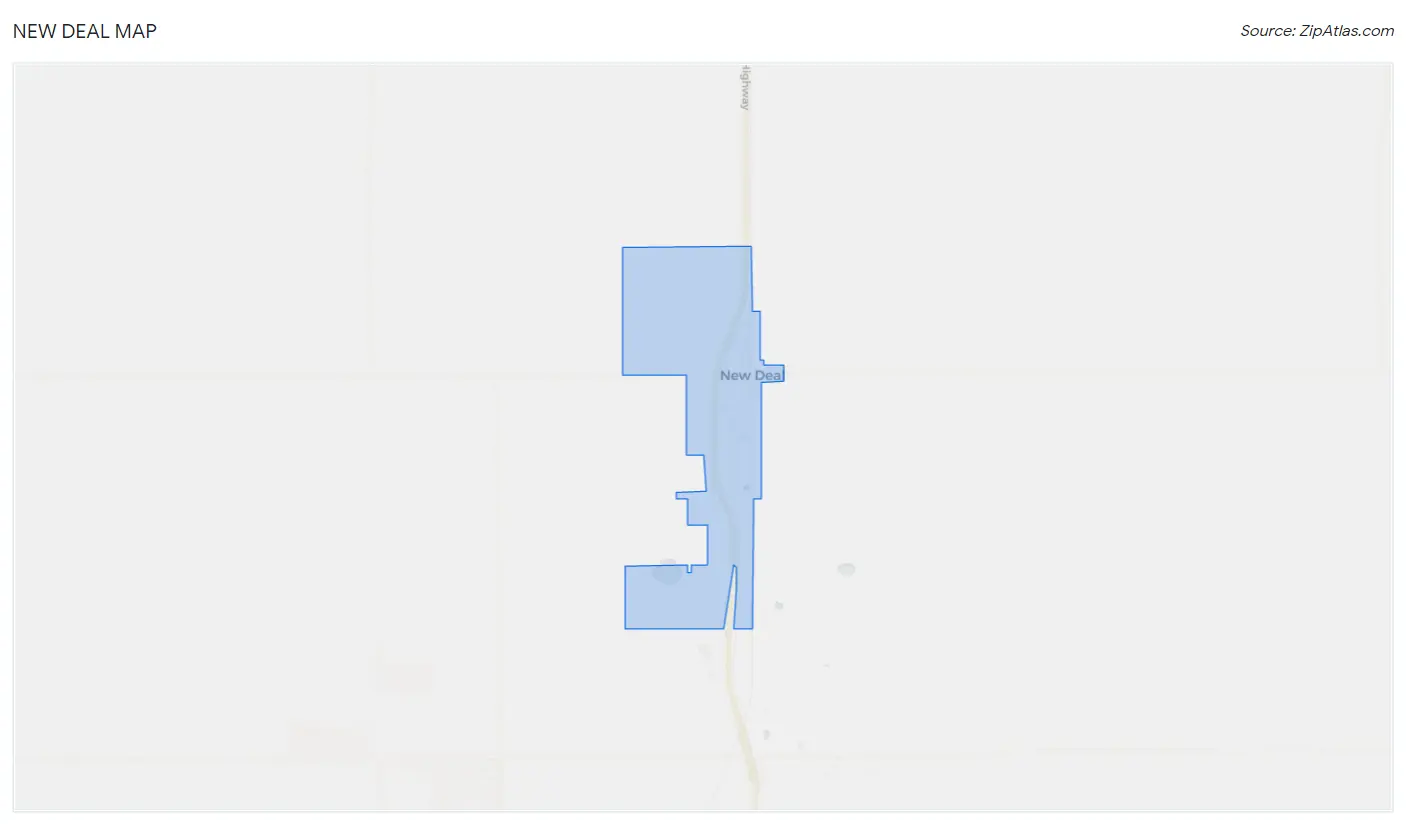
New Deal Overview
$26,216
PER CAPITA INCOME
$90,217
AVG FAMILY INCOME
$76,964
AVG HOUSEHOLD INCOME
25.0%
WAGE / INCOME GAP [ % ]
75.0¢/ $1
WAGE / INCOME GAP [ $ ]
0.39
INEQUALITY / GINI INDEX
1,217
TOTAL POPULATION
606
MALE POPULATION
611
FEMALE POPULATION
99.18
MALES / 100 FEMALES
100.83
FEMALES / 100 MALES
39.1
MEDIAN AGE
3.4
AVG FAMILY SIZE
3.0
AVG HOUSEHOLD SIZE
643
LABOR FORCE [ PEOPLE ]
68.8%
PERCENT IN LABOR FORCE
0.5%
UNEMPLOYMENT RATE
New Deal Zip Codes
New Deal Area Codes
Income in New Deal
Income Overview in New Deal
Per Capita Income in New Deal is $26,216, while median incomes of families and households are $90,217 and $76,964 respectively.
| Characteristic | Number | Measure |
| Per Capita Income | 1,217 | $26,216 |
| Median Family Income | 312 | $90,217 |
| Mean Family Income | 312 | $84,206 |
| Median Household Income | 401 | $76,964 |
| Mean Household Income | 401 | $76,697 |
| Income Deficit | 312 | $0 |
| Wage / Income Gap (%) | 1,217 | 24.98% |
| Wage / Income Gap ($) | 1,217 | 75.02¢ per $1 |
| Gini / Inequality Index | 1,217 | 0.39 |
Earnings by Sex in New Deal
Average Earnings in New Deal are $36,111, $44,046 for men and $33,044 for women, a difference of 25.0%.

| Sex | Number | Average Earnings |
| Male | 301 (46.3%) | $44,046 |
| Female | 349 (53.7%) | $33,044 |
| Total | 650 (100.0%) | $36,111 |
Earnings by Sex by Income Bracket in New Deal
The most common earnings brackets in New Deal are $75,000 to $99,999 for men (45 | 14.9%) and $30,000 to $34,999 for women (62 | 17.8%).
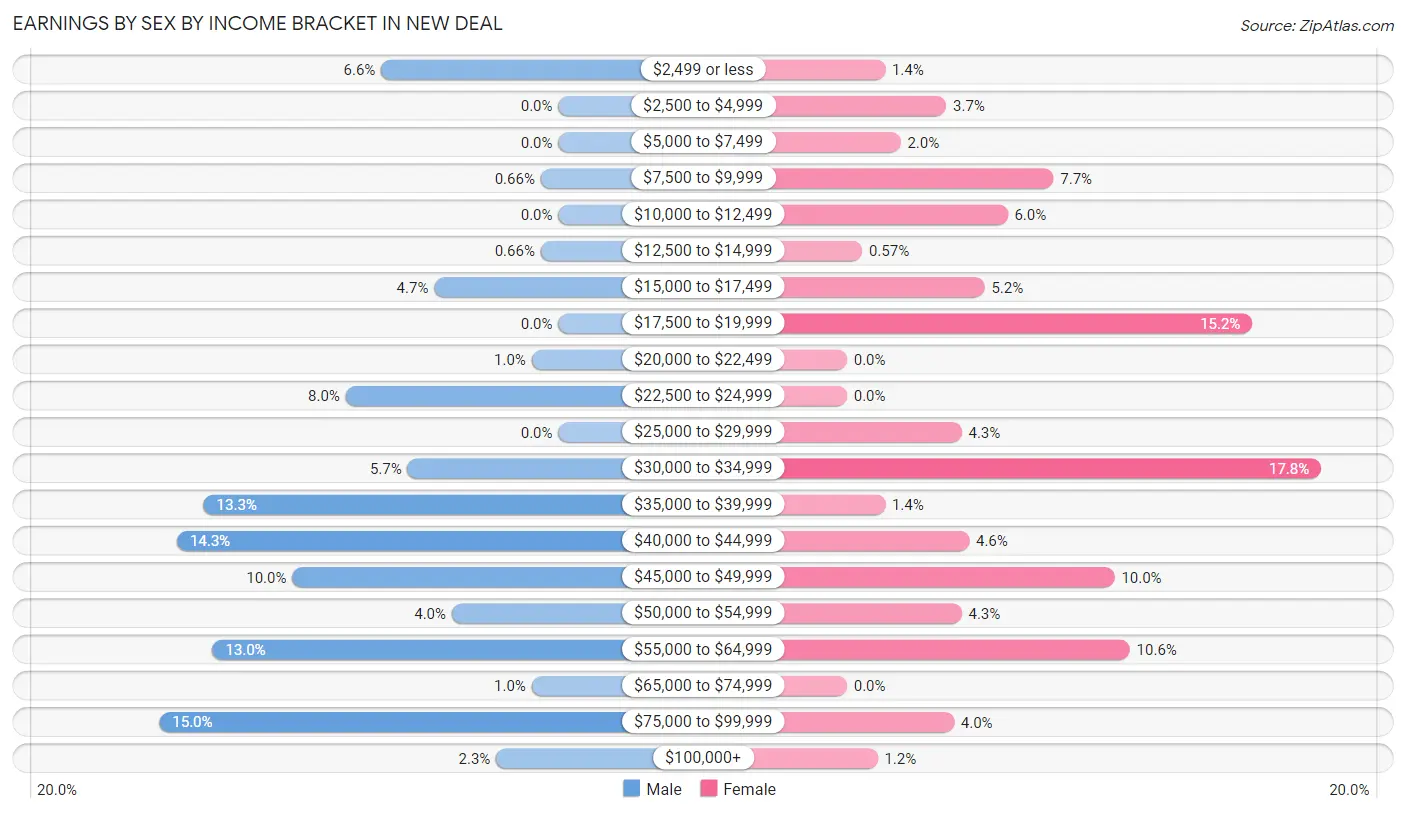
| Income | Male | Female |
| $2,499 or less | 20 (6.6%) | 5 (1.4%) |
| $2,500 to $4,999 | 0 (0.0%) | 13 (3.7%) |
| $5,000 to $7,499 | 0 (0.0%) | 7 (2.0%) |
| $7,500 to $9,999 | 2 (0.7%) | 27 (7.7%) |
| $10,000 to $12,499 | 0 (0.0%) | 21 (6.0%) |
| $12,500 to $14,999 | 2 (0.7%) | 2 (0.6%) |
| $15,000 to $17,499 | 14 (4.6%) | 18 (5.2%) |
| $17,500 to $19,999 | 0 (0.0%) | 53 (15.2%) |
| $20,000 to $22,499 | 3 (1.0%) | 0 (0.0%) |
| $22,500 to $24,999 | 24 (8.0%) | 0 (0.0%) |
| $25,000 to $29,999 | 0 (0.0%) | 15 (4.3%) |
| $30,000 to $34,999 | 17 (5.7%) | 62 (17.8%) |
| $35,000 to $39,999 | 40 (13.3%) | 5 (1.4%) |
| $40,000 to $44,999 | 43 (14.3%) | 16 (4.6%) |
| $45,000 to $49,999 | 30 (10.0%) | 35 (10.0%) |
| $50,000 to $54,999 | 12 (4.0%) | 15 (4.3%) |
| $55,000 to $64,999 | 39 (13.0%) | 37 (10.6%) |
| $65,000 to $74,999 | 3 (1.0%) | 0 (0.0%) |
| $75,000 to $99,999 | 45 (14.9%) | 14 (4.0%) |
| $100,000+ | 7 (2.3%) | 4 (1.1%) |
| Total | 301 (100.0%) | 349 (100.0%) |
Earnings by Sex by Educational Attainment in New Deal
Average earnings in New Deal are $48,462 for men and $34,335 for women, a difference of 29.1%. Men with an educational attainment of college or associate's degree enjoy the highest average annual earnings of $56,402, while those with less than high school education earn the least with $43,681. Women with an educational attainment of bachelor's degree earn the most with the average annual earnings of $58,380, while those with high school diploma education have the smallest earnings of $18,295.

| Educational Attainment | Male Income | Female Income |
| Less than High School | $43,681 | $0 |
| High School Diploma | $46,176 | $18,295 |
| College or Associate's Degree | $56,402 | $34,435 |
| Bachelor's Degree | - | - |
| Graduate Degree | - | - |
| Total | $48,462 | $34,335 |
Family Income in New Deal
Family Income Brackets in New Deal
According to the New Deal family income data, there are 67 families falling into the $75,000 to $99,999 income range, which is the most common income bracket and makes up 21.5% of all families. Conversely, the $200,000+ income bracket is the least frequent group with only 4 families (1.3%) belonging to this category.

| Income Bracket | # Families | % Families |
| Less than $10,000 | 12 | 3.8% |
| $10,000 to $14,999 | 32 | 10.3% |
| $15,000 to $24,999 | 17 | 5.4% |
| $25,000 to $34,999 | 13 | 4.2% |
| $35,000 to $49,999 | 18 | 5.8% |
| $50,000 to $74,999 | 53 | 17.0% |
| $75,000 to $99,999 | 67 | 21.5% |
| $100,000 to $149,999 | 55 | 17.6% |
| $150,000 to $199,999 | 41 | 13.1% |
| $200,000+ | 4 | 1.3% |
Family Income by Famaliy Size in New Deal
3-person families (74 | 23.7%) account for the highest median family income in New Deal with $125,833 per family, while 3-person families (74 | 23.7%) have the highest median income of $41,944 per family member.

| Income Bracket | # Families | Median Income |
| 2-Person Families | 121 (38.8%) | $72,448 |
| 3-Person Families | 74 (23.7%) | $125,833 |
| 4-Person Families | 67 (21.5%) | $0 |
| 5-Person Families | 27 (8.6%) | $0 |
| 6-Person Families | 16 (5.1%) | $0 |
| 7+ Person Families | 7 (2.2%) | $0 |
| Total | 312 (100.0%) | $90,217 |
Family Income by Number of Earners in New Deal

| Number of Earners | # Families | Median Income |
| No Earners | 41 (13.1%) | $0 |
| 1 Earner | 66 (21.1%) | $43,958 |
| 2 Earners | 173 (55.4%) | $91,577 |
| 3+ Earners | 32 (10.3%) | $118,500 |
| Total | 312 (100.0%) | $90,217 |
Household Income in New Deal
Household Income Brackets in New Deal
With 82 households falling in the category, the $75,000 to $99,999 income range is the most frequent in New Deal, accounting for 20.4% of all households. In contrast, only 4 households (1.0%) fall into the $200,000+ income bracket, making it the least populous group.

| Income Bracket | # Households | % Households |
| Less than $10,000 | 12 | 3.0% |
| $10,000 to $14,999 | 22 | 5.5% |
| $15,000 to $24,999 | 65 | 16.2% |
| $25,000 to $34,999 | 23 | 5.7% |
| $35,000 to $49,999 | 46 | 11.5% |
| $50,000 to $74,999 | 27 | 6.7% |
| $75,000 to $99,999 | 82 | 20.4% |
| $100,000 to $149,999 | 79 | 19.7% |
| $150,000 to $199,999 | 41 | 10.2% |
| $200,000+ | 4 | 1.0% |
Household Income by Householder Age in New Deal
The median household income in New Deal is $76,964, with the highest median household income of $95,000 found in the 45 to 64 years age bracket for the primary householder. A total of 208 households (51.9%) fall into this category. Meanwhile, the 15 to 24 years age bracket for the primary householder has the lowest median household income of $0, with 8 households (2.0%) in this group.

| Income Bracket | # Households | Median Income |
| 15 to 24 Years | 8 (2.0%) | $0 |
| 25 to 44 Years | 90 (22.4%) | $43,929 |
| 45 to 64 Years | 208 (51.9%) | $95,000 |
| 65+ Years | 95 (23.7%) | $29,375 |
| Total | 401 (100.0%) | $76,964 |
Poverty in New Deal
Income Below Poverty by Sex and Age in New Deal
With 27.4% poverty level for males and 24.5% for females among the residents of New Deal, 12 to 14 year old males and under 5 year old females are the most vulnerable to poverty, with 68 males (81.9%) and 10 females (100.0%) in their respective age groups living below the poverty level.
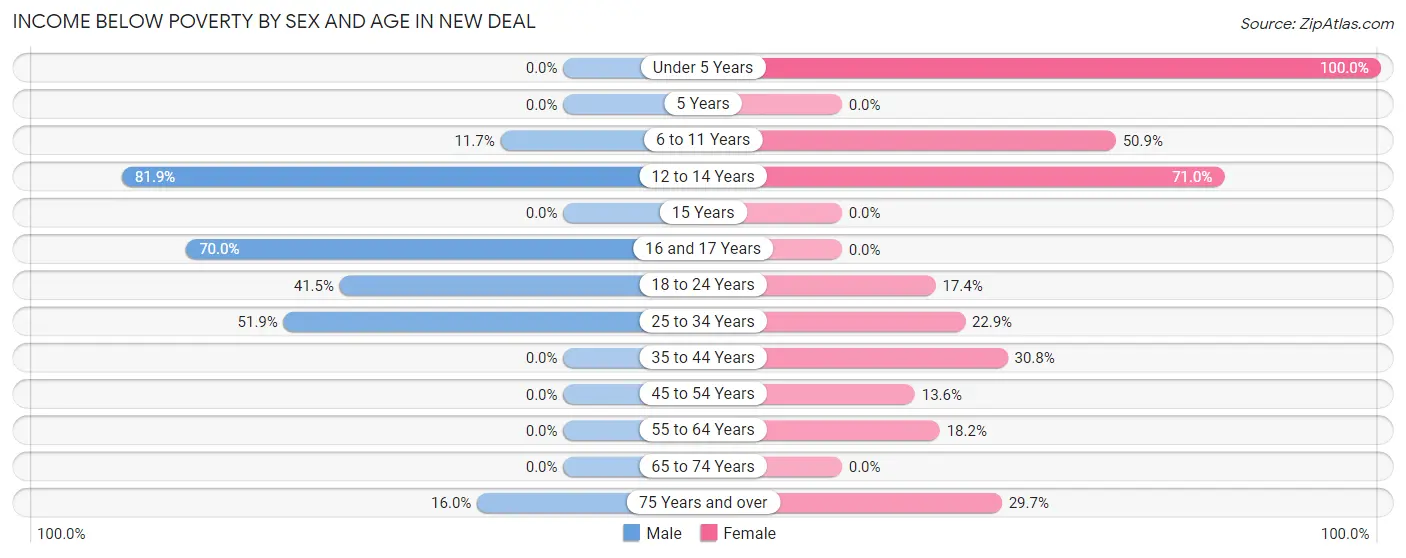
| Age Bracket | Male | Female |
| Under 5 Years | 0 (0.0%) | 10 (100.0%) |
| 5 Years | 0 (0.0%) | 0 (0.0%) |
| 6 to 11 Years | 7 (11.7%) | 30 (50.8%) |
| 12 to 14 Years | 68 (81.9%) | 22 (71.0%) |
| 15 Years | 0 (0.0%) | 0 (0.0%) |
| 16 and 17 Years | 21 (70.0%) | 0 (0.0%) |
| 18 to 24 Years | 39 (41.5%) | 12 (17.4%) |
| 25 to 34 Years | 27 (51.9%) | 8 (22.9%) |
| 35 to 44 Years | 0 (0.0%) | 16 (30.8%) |
| 45 to 54 Years | 0 (0.0%) | 21 (13.6%) |
| 55 to 64 Years | 0 (0.0%) | 12 (18.2%) |
| 65 to 74 Years | 0 (0.0%) | 0 (0.0%) |
| 75 Years and over | 4 (16.0%) | 19 (29.7%) |
| Total | 166 (27.4%) | 150 (24.5%) |
Income Above Poverty by Sex and Age in New Deal
According to the poverty statistics in New Deal, males aged under 5 years and females aged 15 years are the age groups that are most secure financially, with 100.0% of males and 100.0% of females in these age groups living above the poverty line.
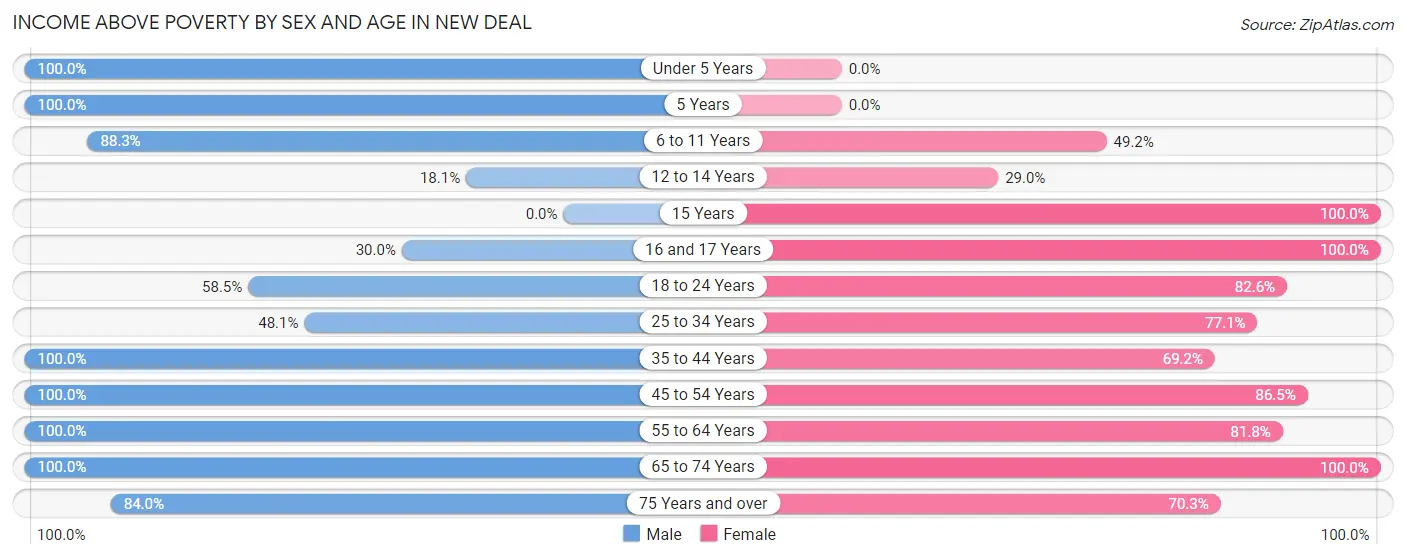
| Age Bracket | Male | Female |
| Under 5 Years | 25 (100.0%) | 0 (0.0%) |
| 5 Years | 10 (100.0%) | 0 (0.0%) |
| 6 to 11 Years | 53 (88.3%) | 29 (49.1%) |
| 12 to 14 Years | 15 (18.1%) | 9 (29.0%) |
| 15 Years | 0 (0.0%) | 4 (100.0%) |
| 16 and 17 Years | 9 (30.0%) | 11 (100.0%) |
| 18 to 24 Years | 55 (58.5%) | 57 (82.6%) |
| 25 to 34 Years | 25 (48.1%) | 27 (77.1%) |
| 35 to 44 Years | 52 (100.0%) | 36 (69.2%) |
| 45 to 54 Years | 95 (100.0%) | 134 (86.5%) |
| 55 to 64 Years | 45 (100.0%) | 54 (81.8%) |
| 65 to 74 Years | 35 (100.0%) | 55 (100.0%) |
| 75 Years and over | 21 (84.0%) | 45 (70.3%) |
| Total | 440 (72.6%) | 461 (75.4%) |
Income Below Poverty Among Married-Couple Families in New Deal
The poverty statistics for married-couple families in New Deal show that 7.7% or 17 of the total 222 families live below the poverty line. Families with 1 or 2 children have the highest poverty rate of 22.7%, comprising of 17 families. On the other hand, families with no children have the lowest poverty rate of 0.0%, which includes 0 families.

| Children | Above Poverty | Below Poverty |
| No Children | 126 (100.0%) | 0 (0.0%) |
| 1 or 2 Children | 58 (77.3%) | 17 (22.7%) |
| 3 or 4 Children | 21 (100.0%) | 0 (0.0%) |
| 5 or more Children | 0 (0.0%) | 0 (0.0%) |
| Total | 205 (92.3%) | 17 (7.7%) |
Income Below Poverty Among Single-Parent Households in New Deal

| Children | Single Father | Single Mother |
| No Children | 0 (0.0%) | 0 (0.0%) |
| 1 or 2 Children | 0 (0.0%) | 33 (100.0%) |
| 3 or 4 Children | 0 (0.0%) | 16 (100.0%) |
| 5 or more Children | 0 (0.0%) | 0 (0.0%) |
| Total | 0 (0.0%) | 49 (59.0%) |
Income Below Poverty Among Married-Couple vs Single-Parent Households in New Deal
The poverty data for New Deal shows that 17 of the married-couple family households (7.7%) and 49 of the single-parent households (54.4%) are living below the poverty level. Within the married-couple family households, those with 1 or 2 children have the highest poverty rate, with 17 households (22.7%) falling below the poverty line. Among the single-parent households, those with 3 or 4 children have the highest poverty rate, with 16 household (100.0%) living below poverty.

| Children | Married-Couple Families | Single-Parent Households |
| No Children | 0 (0.0%) | 0 (0.0%) |
| 1 or 2 Children | 17 (22.7%) | 33 (86.8%) |
| 3 or 4 Children | 0 (0.0%) | 16 (100.0%) |
| 5 or more Children | 0 (0.0%) | 0 (0.0%) |
| Total | 17 (7.7%) | 49 (54.4%) |
Race in New Deal
The most populous races in New Deal are White / Caucasian (858 | 70.5%), Hispanic or Latino (497 | 40.8%), and Two or more Races (179 | 14.7%).

| Race | # Population | % Population |
| Asian | 0 | 0.0% |
| Black / African American | 40 | 3.3% |
| Hawaiian / Pacific | 0 | 0.0% |
| Hispanic or Latino | 497 | 40.8% |
| Native / Alaskan | 66 | 5.4% |
| White / Caucasian | 858 | 70.5% |
| Two or more Races | 179 | 14.7% |
| Some other Race | 74 | 6.1% |
| Total | 1,217 | 100.0% |
Ancestry in New Deal
The most populous ancestries reported in New Deal are Mexican (382 | 31.4%), English (247 | 20.3%), Irish (141 | 11.6%), German (132 | 10.8%), and American (87 | 7.1%), together accounting for 81.3% of all New Deal residents.
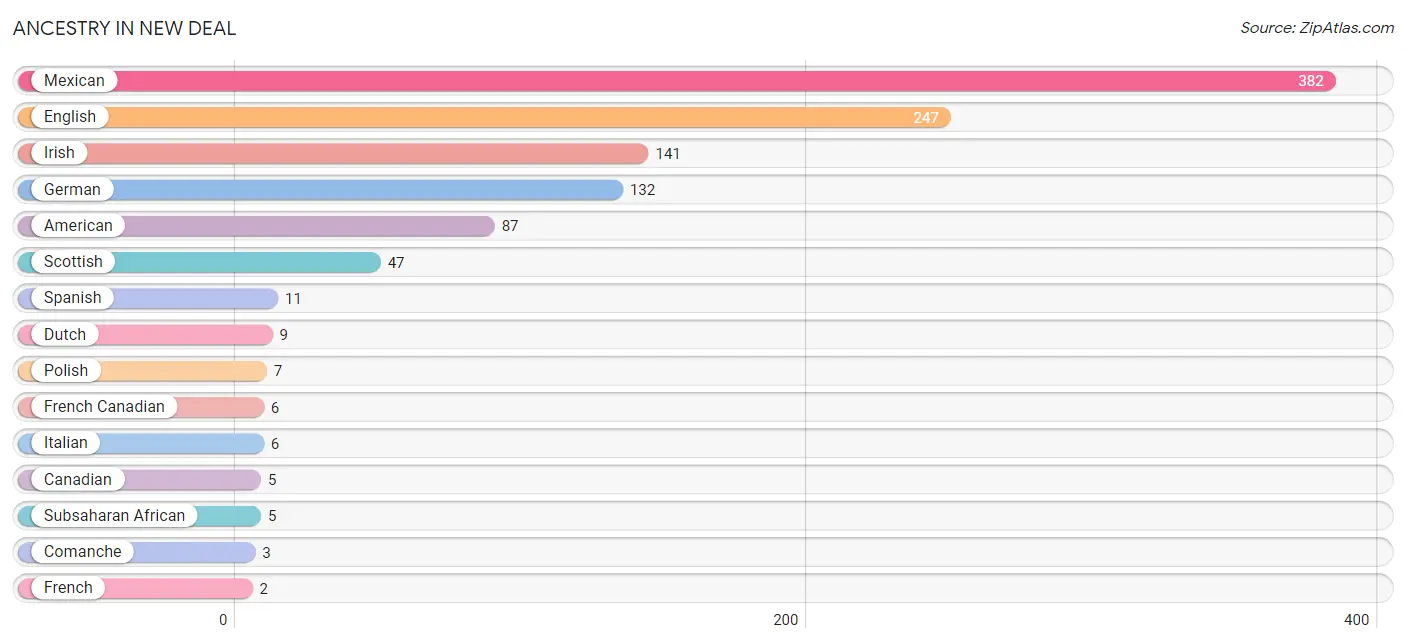
| Ancestry | # Population | % Population |
| American | 87 | 7.1% |
| Canadian | 5 | 0.4% |
| Comanche | 3 | 0.3% |
| Dutch | 9 | 0.7% |
| English | 247 | 20.3% |
| French | 2 | 0.2% |
| French Canadian | 6 | 0.5% |
| German | 132 | 10.8% |
| Irish | 141 | 11.6% |
| Italian | 6 | 0.5% |
| Mexican | 382 | 31.4% |
| Norwegian | 2 | 0.2% |
| Polish | 7 | 0.6% |
| Scottish | 47 | 3.9% |
| Spanish | 11 | 0.9% |
| Subsaharan African | 5 | 0.4% | View All 16 Rows |
Immigrants in New Deal
The most numerous immigrant groups reported in New Deal came from Central America (40 | 3.3%), Latin America (40 | 3.3%), and Mexico (40 | 3.3%), together accounting for 9.9% of all New Deal residents.

| Immigration Origin | # Population | % Population |
| Central America | 40 | 3.3% |
| Latin America | 40 | 3.3% |
| Mexico | 40 | 3.3% | View All 3 Rows |
Sex and Age in New Deal
Sex and Age in New Deal
The most populous age groups in New Deal are 10 to 14 Years (125 | 20.6%) for men and 45 to 49 Years (100 | 16.4%) for women.
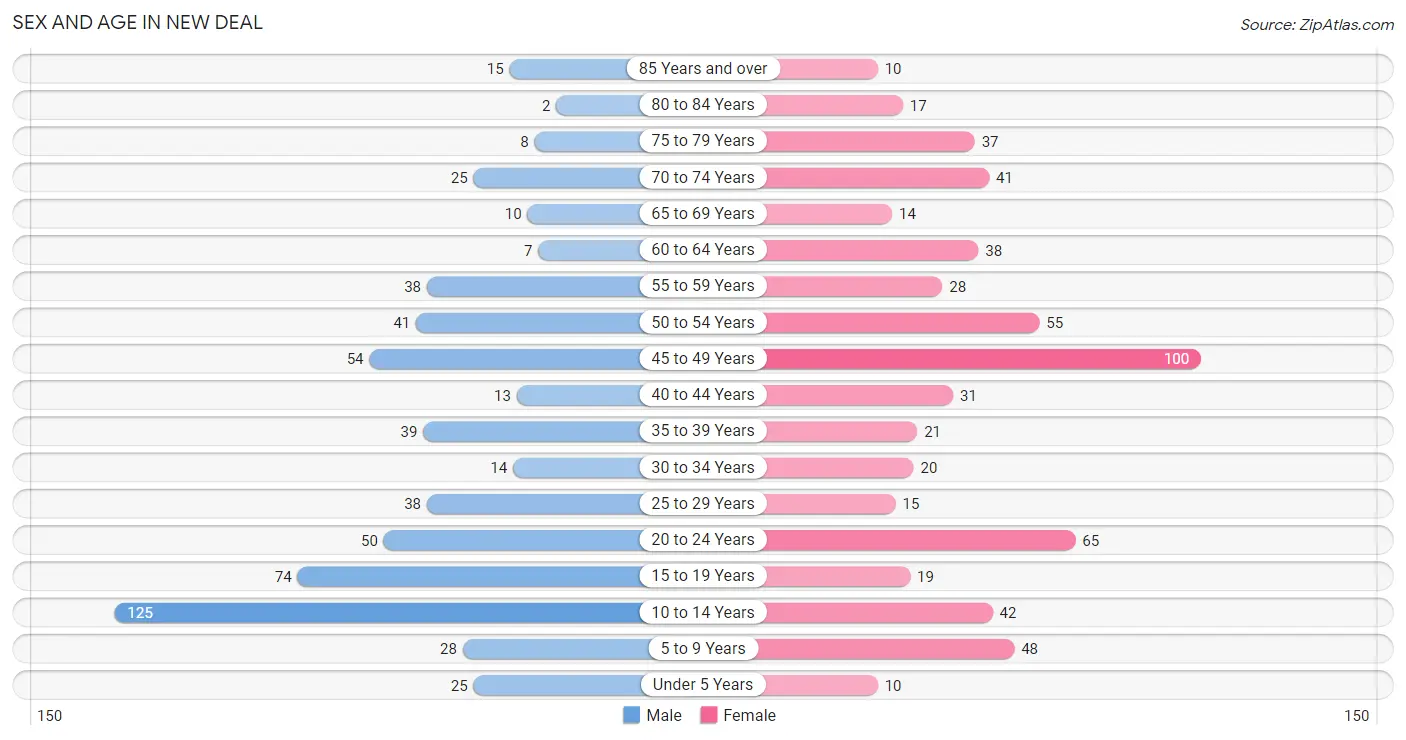
| Age Bracket | Male | Female |
| Under 5 Years | 25 (4.1%) | 10 (1.6%) |
| 5 to 9 Years | 28 (4.6%) | 48 (7.9%) |
| 10 to 14 Years | 125 (20.6%) | 42 (6.9%) |
| 15 to 19 Years | 74 (12.2%) | 19 (3.1%) |
| 20 to 24 Years | 50 (8.3%) | 65 (10.6%) |
| 25 to 29 Years | 38 (6.3%) | 15 (2.5%) |
| 30 to 34 Years | 14 (2.3%) | 20 (3.3%) |
| 35 to 39 Years | 39 (6.4%) | 21 (3.4%) |
| 40 to 44 Years | 13 (2.1%) | 31 (5.1%) |
| 45 to 49 Years | 54 (8.9%) | 100 (16.4%) |
| 50 to 54 Years | 41 (6.8%) | 55 (9.0%) |
| 55 to 59 Years | 38 (6.3%) | 28 (4.6%) |
| 60 to 64 Years | 7 (1.2%) | 38 (6.2%) |
| 65 to 69 Years | 10 (1.7%) | 14 (2.3%) |
| 70 to 74 Years | 25 (4.1%) | 41 (6.7%) |
| 75 to 79 Years | 8 (1.3%) | 37 (6.1%) |
| 80 to 84 Years | 2 (0.3%) | 17 (2.8%) |
| 85 Years and over | 15 (2.5%) | 10 (1.6%) |
| Total | 606 (100.0%) | 611 (100.0%) |
Families and Households in New Deal
Median Family Size in New Deal
The median family size in New Deal is 3.37 persons per family, with single female/mother families (83 | 26.6%) accounting for the largest median family size of 3.57 persons per family. On the other hand, single male/father families (7 | 2.2%) represent the smallest median family size with 2.71 persons per family.

| Family Type | # Families | Family Size |
| Married-Couple | 222 (71.2%) | 3.32 |
| Single Male/Father | 7 (2.2%) | 2.71 |
| Single Female/Mother | 83 (26.6%) | 3.57 |
| Total Families | 312 (100.0%) | 3.37 |
Median Household Size in New Deal
The median household size in New Deal is 3.03 persons per household, with single female/mother households (83 | 20.7%) accounting for the largest median household size of 4.28 persons per household. non-family households (89 | 22.2%) represent the smallest median household size with 1.02 persons per household.

| Household Type | # Households | Household Size |
| Married-Couple | 222 (55.4%) | 3.36 |
| Single Male/Father | 7 (1.8%) | 3.43 |
| Single Female/Mother | 83 (20.7%) | 4.28 |
| Non-family | 89 (22.2%) | 1.02 |
| Total Households | 401 (100.0%) | 3.03 |
Household Size by Marriage Status in New Deal
Out of a total of 401 households in New Deal, 312 (77.8%) are family households, while 89 (22.2%) are nonfamily households. The most numerous type of family households are 2-person households, comprising 99, and the most common type of nonfamily households are 1-person households, comprising 88.

| Household Size | Family Households | Nonfamily Households |
| 1-Person Households | - | 88 (22.0%) |
| 2-Person Households | 99 (24.7%) | 1 (0.3%) |
| 3-Person Households | 91 (22.7%) | 0 (0.0%) |
| 4-Person Households | 51 (12.7%) | 0 (0.0%) |
| 5-Person Households | 48 (12.0%) | 0 (0.0%) |
| 6-Person Households | 16 (4.0%) | 0 (0.0%) |
| 7+ Person Households | 7 (1.8%) | 0 (0.0%) |
| Total | 312 (77.8%) | 89 (22.2%) |
Female Fertility in New Deal
Fertility by Age in New Deal
Average fertility rate in New Deal is 44.0 births per 1,000 women. Women in the age bracket of 20 to 34 years have the highest fertility rate with 120.0 births per 1,000 women. Women in the age bracket of 20 to 34 years acount for 100.0% of all women with births.

| Age Bracket | Women with Births | Births / 1,000 Women |
| 15 to 19 years | 0 (0.0%) | 0.0 |
| 20 to 34 years | 12 (100.0%) | 120.0 |
| 35 to 50 years | 0 (0.0%) | 0.0 |
| Total | 12 (100.0%) | 44.0 |
Fertility by Age by Marriage Status in New Deal

| Age Bracket | Married | Unmarried |
| 15 to 19 years | 0 (0.0%) | 0 (0.0%) |
| 20 to 34 years | 12 (100.0%) | 0 (0.0%) |
| 35 to 50 years | 0 (0.0%) | 0 (0.0%) |
| Total | 12 (100.0%) | 0 (0.0%) |
Fertility by Education in New Deal
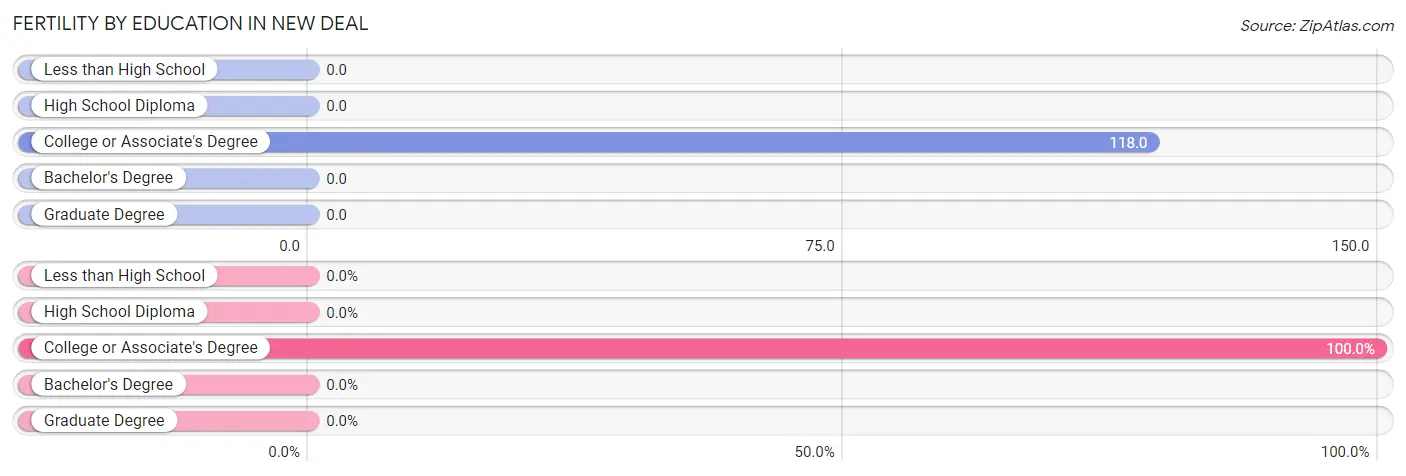
| Educational Attainment | Women with Births | Births / 1,000 Women |
| Less than High School | 0 (0.0%) | 0.0 |
| High School Diploma | 0 (0.0%) | 0.0 |
| College or Associate's Degree | 12 (100.0%) | 118.0 |
| Bachelor's Degree | 0 (0.0%) | 0.0 |
| Graduate Degree | 0 (0.0%) | 0.0 |
| Total | 12 (100.0%) | 44.0 |
Fertility by Education by Marriage Status in New Deal

| Educational Attainment | Married | Unmarried |
| Less than High School | 0 (0.0%) | 0 (0.0%) |
| High School Diploma | 0 (0.0%) | 0 (0.0%) |
| College or Associate's Degree | 12 (100.0%) | 0 (0.0%) |
| Bachelor's Degree | 0 (0.0%) | 0 (0.0%) |
| Graduate Degree | 0 (0.0%) | 0 (0.0%) |
| Total | 12 (100.0%) | 0 (0.0%) |
Employment Characteristics in New Deal
Employment by Class of Employer in New Deal
Among the 618 employed individuals in New Deal, private company employees (531 | 85.9%), self-employed (not incorporated) (35 | 5.7%), and not-for-profit organizations (19 | 3.1%) make up the most common classes of employment.

| Employer Class | # Employees | % Employees |
| Private Company Employees | 531 | 85.9% |
| Self-Employed (Incorporated) | 0 | 0.0% |
| Self-Employed (Not Incorporated) | 35 | 5.7% |
| Not-for-profit Organizations | 19 | 3.1% |
| Local Government Employees | 14 | 2.3% |
| State Government Employees | 10 | 1.6% |
| Federal Government Employees | 9 | 1.5% |
| Unpaid Family Workers | 0 | 0.0% |
| Total | 618 | 100.0% |
Employment Status by Age in New Deal
According to the labor force statistics for New Deal, out of the total population over 16 years of age (935), 68.8% or 643 individuals are in the labor force, with 0.5% or 3 of them unemployed. The age group with the highest labor force participation rate is 45 to 54 years, with 100.0% or 250 individuals in the labor force. Within the labor force, the 35 to 44 years age range has the highest percentage of unemployed individuals, with 3.2% or 3 of them being unemployed.

| Age Bracket | In Labor Force | Unemployed |
| 16 to 19 Years | 29 (32.6%) | 0 (0.0%) |
| 20 to 24 Years | 113 (98.3%) | 0 (0.0%) |
| 25 to 29 Years | 24 (45.3%) | 0 (0.0%) |
| 30 to 34 Years | 30 (88.2%) | 0 (0.0%) |
| 35 to 44 Years | 95 (91.3%) | 3 (3.2%) |
| 45 to 54 Years | 250 (100.0%) | 0 (0.0%) |
| 55 to 59 Years | 43 (65.2%) | 0 (0.0%) |
| 60 to 64 Years | 34 (75.6%) | 0 (0.0%) |
| 65 to 74 Years | 19 (21.1%) | 0 (0.0%) |
| 75 Years and over | 6 (6.7%) | 0 (0.0%) |
| Total | 643 (68.8%) | 3 (0.5%) |
Employment Status by Educational Attainment in New Deal
According to labor force statistics for New Deal, 86.2% of individuals (476) out of the total population between 25 and 64 years of age (552) are in the labor force, with 0.6% or 3 of them being unemployed. The group with the highest labor force participation rate are those with the educational attainment of bachelor's degree or higher, with 100.0% or 56 individuals in the labor force. Within the labor force, individuals with high school diploma education have the highest percentage of unemployment, with 1.6% or 3 of them being unemployed.

| Educational Attainment | In Labor Force | Unemployed |
| Less than High School | 38 (65.5%) | 0 (0.0%) |
| High School Diploma | 185 (89.8%) | 3 (1.6%) |
| College / Associate Degree | 197 (84.9%) | 0 (0.0%) |
| Bachelor's Degree or higher | 56 (100.0%) | 0 (0.0%) |
| Total | 476 (86.2%) | 3 (0.6%) |
Employment Occupations by Sex in New Deal
Management, Business, Science and Arts Occupations
The most common Management, Business, Science and Arts occupations in New Deal are Community & Social Service (52 | 8.1%), Management (50 | 7.8%), Health Diagnosing & Treating (49 | 7.7%), Education Instruction & Library (39 | 6.1%), and Business & Financial (28 | 4.4%).
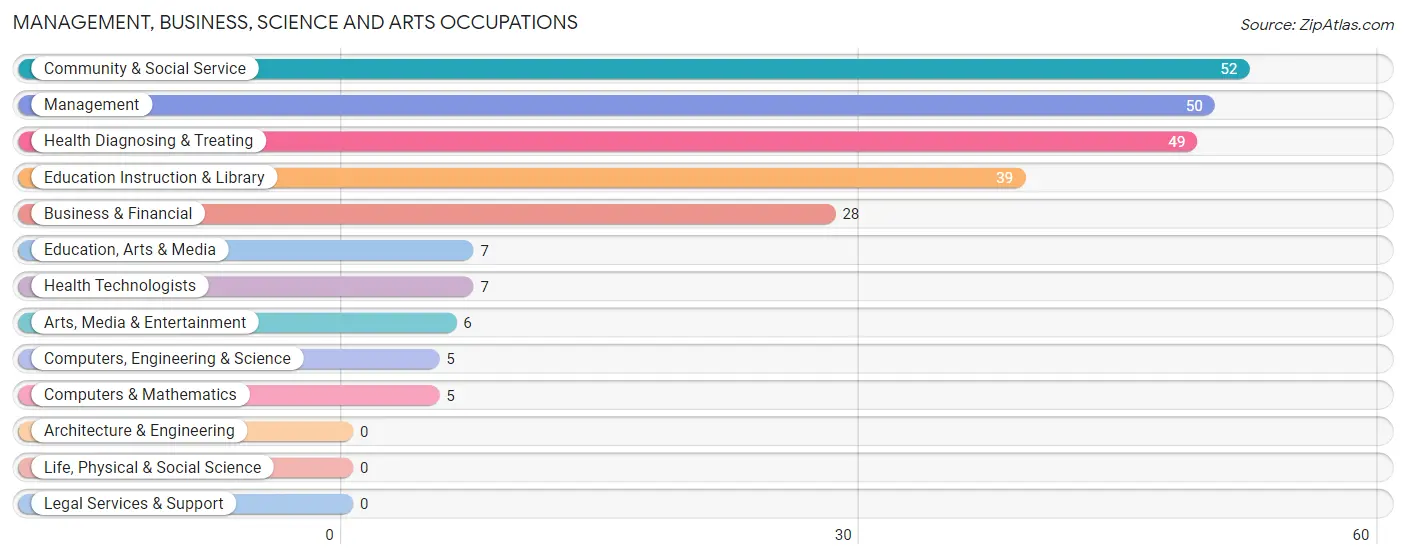
Management, Business, Science and Arts Occupations by Sex
Within the Management, Business, Science and Arts occupations in New Deal, the most male-oriented occupations are Computers, Engineering & Science (100.0%), Computers & Mathematics (100.0%), and Education, Arts & Media (100.0%), while the most female-oriented occupations are Business & Financial (100.0%), Health Technologists (100.0%), and Education Instruction & Library (94.9%).
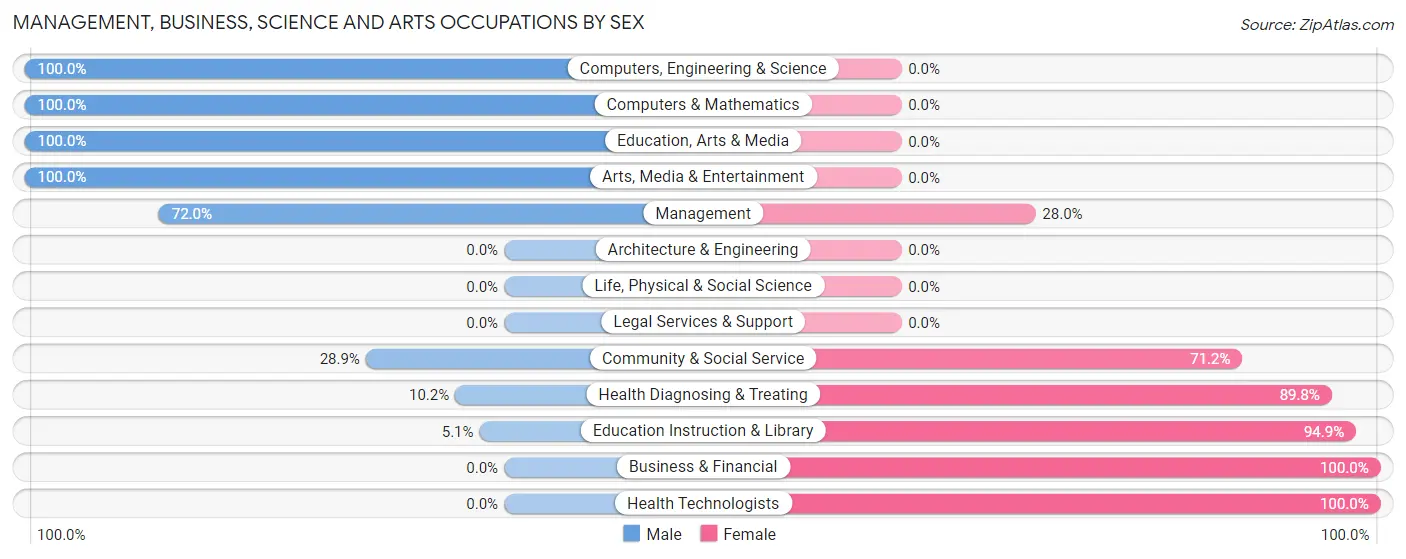
| Occupation | Male | Female |
| Management | 36 (72.0%) | 14 (28.0%) |
| Business & Financial | 0 (0.0%) | 28 (100.0%) |
| Computers, Engineering & Science | 5 (100.0%) | 0 (0.0%) |
| Computers & Mathematics | 5 (100.0%) | 0 (0.0%) |
| Architecture & Engineering | 0 (0.0%) | 0 (0.0%) |
| Life, Physical & Social Science | 0 (0.0%) | 0 (0.0%) |
| Community & Social Service | 15 (28.8%) | 37 (71.2%) |
| Education, Arts & Media | 7 (100.0%) | 0 (0.0%) |
| Legal Services & Support | 0 (0.0%) | 0 (0.0%) |
| Education Instruction & Library | 2 (5.1%) | 37 (94.9%) |
| Arts, Media & Entertainment | 6 (100.0%) | 0 (0.0%) |
| Health Diagnosing & Treating | 5 (10.2%) | 44 (89.8%) |
| Health Technologists | 0 (0.0%) | 7 (100.0%) |
| Total (Category) | 61 (33.2%) | 123 (66.8%) |
| Total (Overall) | 301 (47.0%) | 339 (53.0%) |
Services Occupations
The most common Services occupations in New Deal are Healthcare Support (64 | 10.0%), Cleaning & Maintenance (44 | 6.9%), and Food Preparation & Serving (3 | 0.5%).

Services Occupations by Sex
Within the Services occupations in New Deal, the most male-oriented occupations are Food Preparation & Serving (100.0%), and Cleaning & Maintenance (77.3%), while the most female-oriented occupations are Healthcare Support (100.0%), and Cleaning & Maintenance (22.7%).

| Occupation | Male | Female |
| Healthcare Support | 0 (0.0%) | 64 (100.0%) |
| Security & Protection | 0 (0.0%) | 0 (0.0%) |
| Firefighting & Prevention | 0 (0.0%) | 0 (0.0%) |
| Law Enforcement | 0 (0.0%) | 0 (0.0%) |
| Food Preparation & Serving | 3 (100.0%) | 0 (0.0%) |
| Cleaning & Maintenance | 34 (77.3%) | 10 (22.7%) |
| Personal Care & Service | 0 (0.0%) | 0 (0.0%) |
| Total (Category) | 37 (33.3%) | 74 (66.7%) |
| Total (Overall) | 301 (47.0%) | 339 (53.0%) |
Sales and Office Occupations
The most common Sales and Office occupations in New Deal are Office & Administration (122 | 19.1%), and Sales & Related (49 | 7.7%).

Sales and Office Occupations by Sex

| Occupation | Male | Female |
| Sales & Related | 36 (73.5%) | 13 (26.5%) |
| Office & Administration | 12 (9.8%) | 110 (90.2%) |
| Total (Category) | 48 (28.1%) | 123 (71.9%) |
| Total (Overall) | 301 (47.0%) | 339 (53.0%) |
Natural Resources, Construction and Maintenance Occupations
The most common Natural Resources, Construction and Maintenance occupations in New Deal are Construction & Extraction (97 | 15.2%), and Installation, Maintenance & Repair (5 | 0.8%).

Natural Resources, Construction and Maintenance Occupations by Sex

| Occupation | Male | Female |
| Farming, Fishing & Forestry | 0 (0.0%) | 0 (0.0%) |
| Construction & Extraction | 89 (91.7%) | 8 (8.3%) |
| Installation, Maintenance & Repair | 5 (100.0%) | 0 (0.0%) |
| Total (Category) | 94 (92.2%) | 8 (7.8%) |
| Total (Overall) | 301 (47.0%) | 339 (53.0%) |
Production, Transportation and Moving Occupations
The most common Production, Transportation and Moving occupations in New Deal are Transportation (33 | 5.2%), Production (28 | 4.4%), and Material Moving (11 | 1.7%).

Production, Transportation and Moving Occupations by Sex

| Occupation | Male | Female |
| Production | 28 (100.0%) | 0 (0.0%) |
| Transportation | 33 (100.0%) | 0 (0.0%) |
| Material Moving | 0 (0.0%) | 11 (100.0%) |
| Total (Category) | 61 (84.7%) | 11 (15.3%) |
| Total (Overall) | 301 (47.0%) | 339 (53.0%) |
Employment Industries by Sex in New Deal
Employment Industries in New Deal
The major employment industries in New Deal include Construction (187 | 29.2%), Health Care & Social Assistance (128 | 20.0%), Educational Services (96 | 15.0%), Retail Trade (77 | 12.0%), and Professional & Scientific (27 | 4.2%).
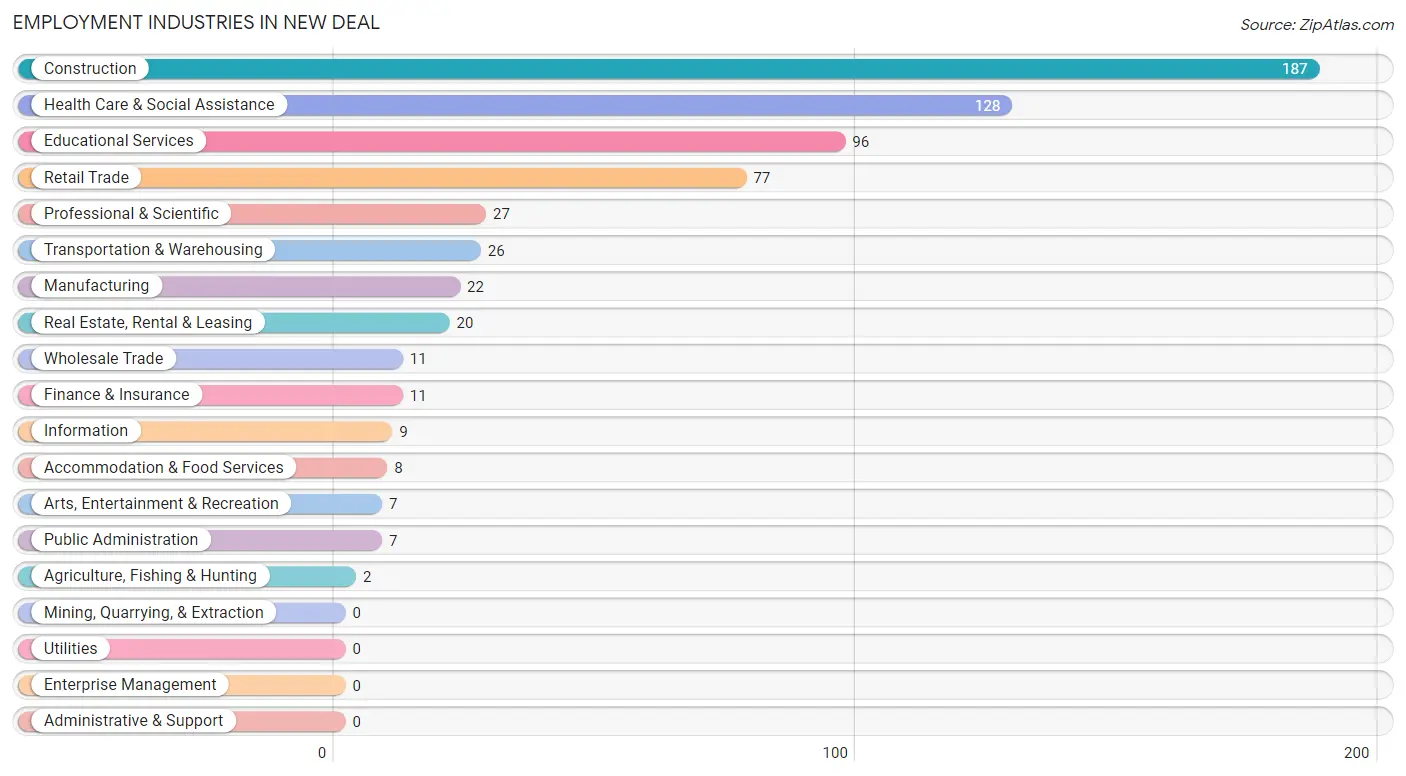
Employment Industries by Sex in New Deal
The New Deal industries that see more men than women are Real Estate, Rental & Leasing (100.0%), Accommodation & Food Services (100.0%), and Manufacturing (95.5%), whereas the industries that tend to have a higher number of women are Agriculture, Fishing & Hunting (100.0%), Wholesale Trade (100.0%), and Arts, Entertainment & Recreation (100.0%).
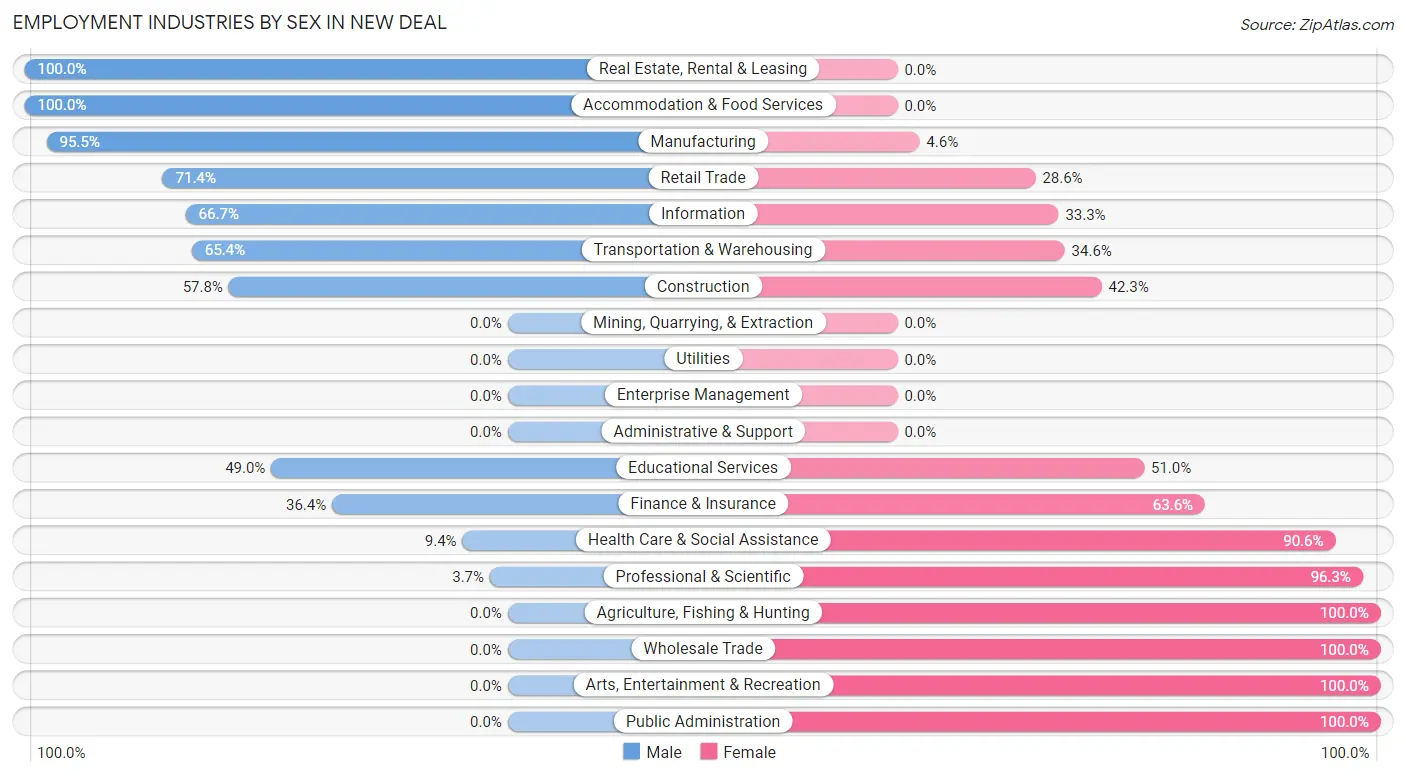
| Industry | Male | Female |
| Agriculture, Fishing & Hunting | 0 (0.0%) | 2 (100.0%) |
| Mining, Quarrying, & Extraction | 0 (0.0%) | 0 (0.0%) |
| Construction | 108 (57.8%) | 79 (42.2%) |
| Manufacturing | 21 (95.5%) | 1 (4.5%) |
| Wholesale Trade | 0 (0.0%) | 11 (100.0%) |
| Retail Trade | 55 (71.4%) | 22 (28.6%) |
| Transportation & Warehousing | 17 (65.4%) | 9 (34.6%) |
| Utilities | 0 (0.0%) | 0 (0.0%) |
| Information | 6 (66.7%) | 3 (33.3%) |
| Finance & Insurance | 4 (36.4%) | 7 (63.6%) |
| Real Estate, Rental & Leasing | 20 (100.0%) | 0 (0.0%) |
| Professional & Scientific | 1 (3.7%) | 26 (96.3%) |
| Enterprise Management | 0 (0.0%) | 0 (0.0%) |
| Administrative & Support | 0 (0.0%) | 0 (0.0%) |
| Educational Services | 47 (49.0%) | 49 (51.0%) |
| Health Care & Social Assistance | 12 (9.4%) | 116 (90.6%) |
| Arts, Entertainment & Recreation | 0 (0.0%) | 7 (100.0%) |
| Accommodation & Food Services | 8 (100.0%) | 0 (0.0%) |
| Public Administration | 0 (0.0%) | 7 (100.0%) |
| Total | 301 (47.0%) | 339 (53.0%) |
Education in New Deal
School Enrollment in New Deal
The most common levels of schooling among the 356 students in New Deal are middle school (153 | 43.0%), high school (77 | 21.6%), and elementary school (61 | 17.1%).

| School Level | # Students | % Students |
| Nursery / Preschool | 8 | 2.2% |
| Kindergarten | 18 | 5.1% |
| Elementary School | 61 | 17.1% |
| Middle School | 153 | 43.0% |
| High School | 77 | 21.6% |
| College / Undergraduate | 37 | 10.4% |
| Graduate / Professional | 2 | 0.6% |
| Total | 356 | 100.0% |
School Enrollment by Age by Funding Source in New Deal
Out of a total of 356 students who are enrolled in schools in New Deal, 24 (6.7%) attend a private institution, while the remaining 332 (93.3%) are enrolled in public schools. The age group of 35 years and over has the highest likelihood of being enrolled in private schools, with 2 (100.0% in the age bracket) enrolled. Conversely, the age group of 3 to 4 year olds has the lowest likelihood of being enrolled in a private school, with 8 (100.0% in the age bracket) attending a public institution.

| Age Bracket | Public School | Private School |
| 3 to 4 Year Olds | 8 (100.0%) | 0 (0.0%) |
| 5 to 9 Year Old | 62 (84.9%) | 11 (15.1%) |
| 10 to 14 Year Olds | 156 (93.4%) | 11 (6.6%) |
| 15 to 17 Year Olds | 45 (100.0%) | 0 (0.0%) |
| 18 to 19 Year Olds | 46 (100.0%) | 0 (0.0%) |
| 20 to 24 Year Olds | 15 (100.0%) | 0 (0.0%) |
| 25 to 34 Year Olds | 0 (0.0%) | 0 (0.0%) |
| 35 Years and over | 0 (0.0%) | 2 (100.0%) |
| Total | 332 (93.3%) | 24 (6.7%) |
Educational Attainment by Field of Study in New Deal
Education (31 | 41.3%), science & technology (16 | 21.3%), bio, nature & agricultural (9 | 12.0%), liberal arts & history (9 | 12.0%), and engineering (7 | 9.3%) are the most common fields of study among 75 individuals in New Deal who have obtained a bachelor's degree or higher.
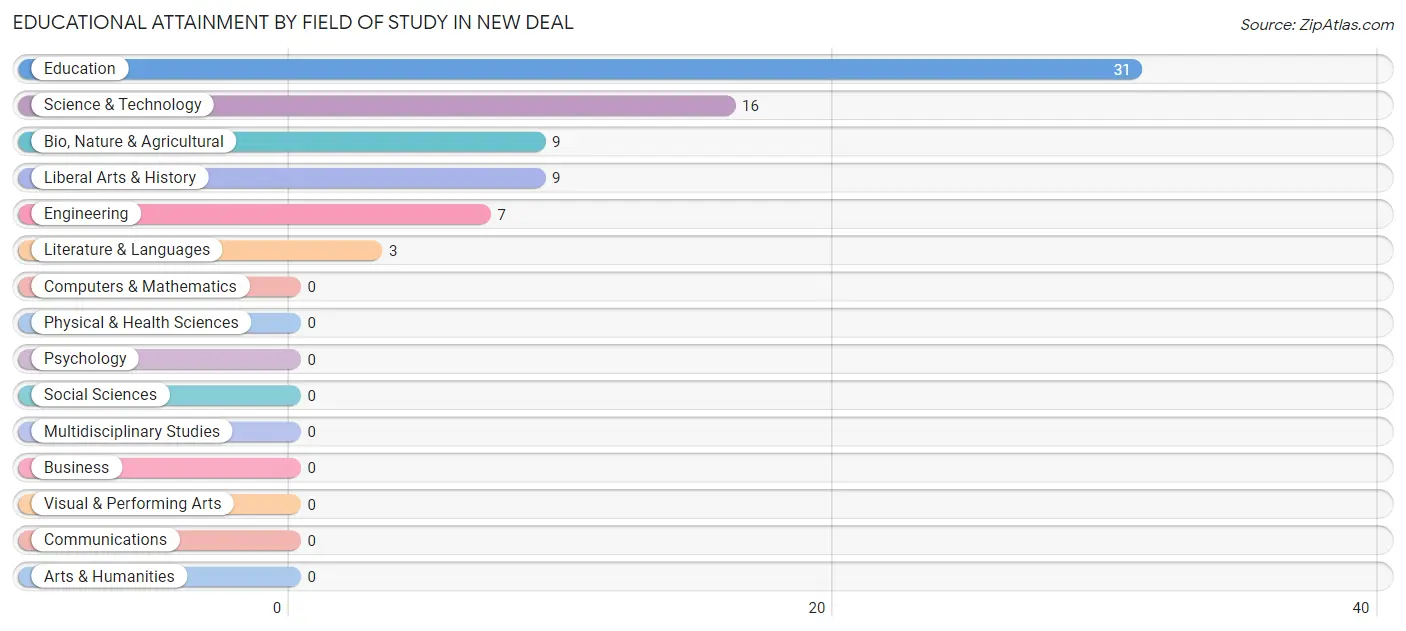
| Field of Study | # Graduates | % Graduates |
| Computers & Mathematics | 0 | 0.0% |
| Bio, Nature & Agricultural | 9 | 12.0% |
| Physical & Health Sciences | 0 | 0.0% |
| Psychology | 0 | 0.0% |
| Social Sciences | 0 | 0.0% |
| Engineering | 7 | 9.3% |
| Multidisciplinary Studies | 0 | 0.0% |
| Science & Technology | 16 | 21.3% |
| Business | 0 | 0.0% |
| Education | 31 | 41.3% |
| Literature & Languages | 3 | 4.0% |
| Liberal Arts & History | 9 | 12.0% |
| Visual & Performing Arts | 0 | 0.0% |
| Communications | 0 | 0.0% |
| Arts & Humanities | 0 | 0.0% |
| Total | 75 | 100.0% |
Transportation & Commute in New Deal
Vehicle Availability by Sex in New Deal
The most prevalent vehicle ownership categories in New Deal are males with 3 vehicles (142, accounting for 47.2%) and females with 3 vehicles (182, making up 44.8%).

| Vehicles Available | Male | Female |
| No Vehicle | 0 (0.0%) | 0 (0.0%) |
| 1 Vehicle | 59 (19.6%) | 18 (5.7%) |
| 2 Vehicles | 86 (28.6%) | 105 (33.1%) |
| 3 Vehicles | 142 (47.2%) | 182 (57.4%) |
| 4 Vehicles | 14 (4.6%) | 12 (3.8%) |
| 5 or more Vehicles | 0 (0.0%) | 0 (0.0%) |
| Total | 301 (100.0%) | 317 (100.0%) |
Commute Time in New Deal
The most frequently occuring commute durations in New Deal are 20 to 24 minutes (107 commuters, 20.2%), 10 to 14 minutes (103 commuters, 19.4%), and less than 5 minutes (66 commuters, 12.4%).
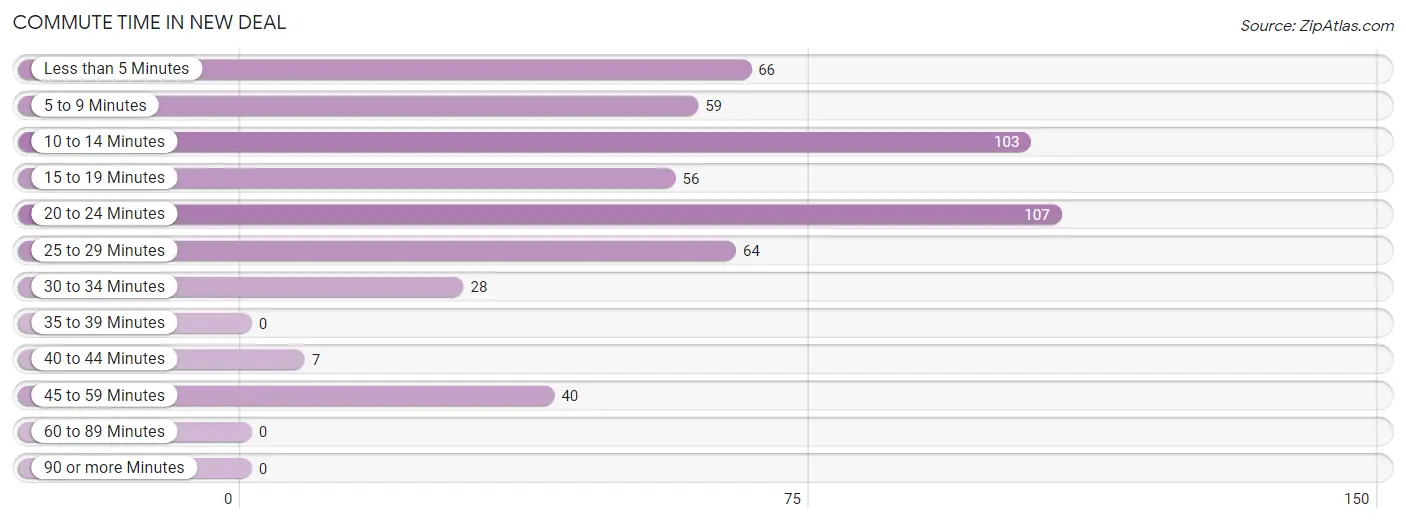
| Commute Time | # Commuters | % Commuters |
| Less than 5 Minutes | 66 | 12.4% |
| 5 to 9 Minutes | 59 | 11.1% |
| 10 to 14 Minutes | 103 | 19.4% |
| 15 to 19 Minutes | 56 | 10.6% |
| 20 to 24 Minutes | 107 | 20.2% |
| 25 to 29 Minutes | 64 | 12.1% |
| 30 to 34 Minutes | 28 | 5.3% |
| 35 to 39 Minutes | 0 | 0.0% |
| 40 to 44 Minutes | 7 | 1.3% |
| 45 to 59 Minutes | 40 | 7.5% |
| 60 to 89 Minutes | 0 | 0.0% |
| 90 or more Minutes | 0 | 0.0% |
Commute Time by Sex in New Deal
The most common commute times in New Deal are less than 5 minutes (55 commuters, 19.0%) for males and 10 to 14 minutes (88 commuters, 36.7%) for females.
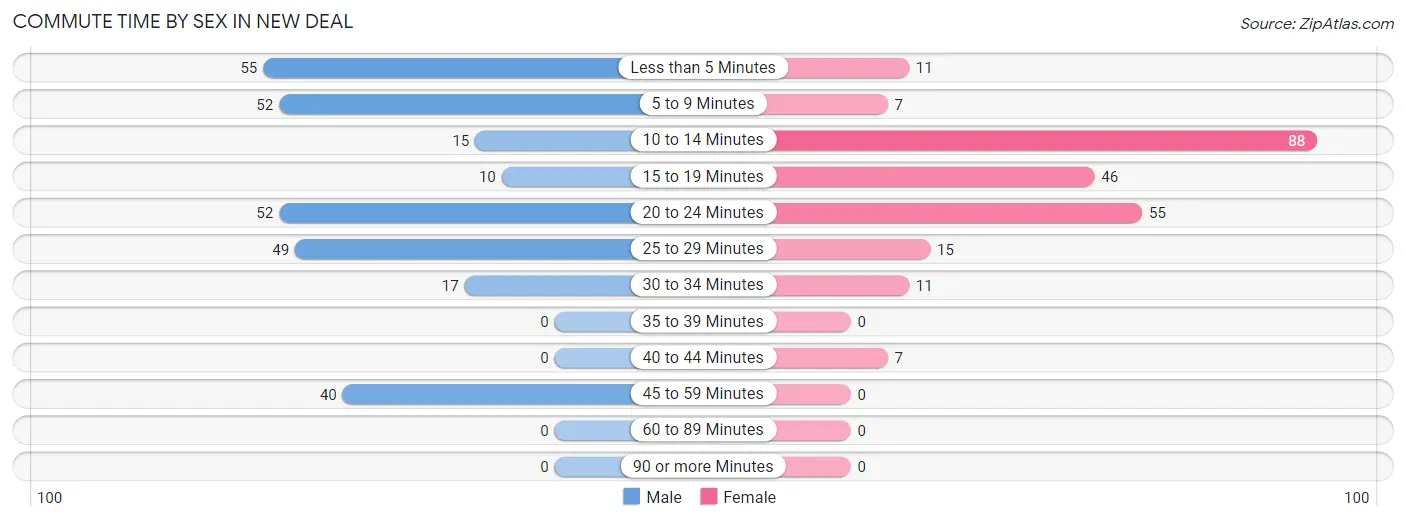
| Commute Time | Male | Female |
| Less than 5 Minutes | 55 (19.0%) | 11 (4.6%) |
| 5 to 9 Minutes | 52 (17.9%) | 7 (2.9%) |
| 10 to 14 Minutes | 15 (5.2%) | 88 (36.7%) |
| 15 to 19 Minutes | 10 (3.5%) | 46 (19.2%) |
| 20 to 24 Minutes | 52 (17.9%) | 55 (22.9%) |
| 25 to 29 Minutes | 49 (16.9%) | 15 (6.2%) |
| 30 to 34 Minutes | 17 (5.9%) | 11 (4.6%) |
| 35 to 39 Minutes | 0 (0.0%) | 0 (0.0%) |
| 40 to 44 Minutes | 0 (0.0%) | 7 (2.9%) |
| 45 to 59 Minutes | 40 (13.8%) | 0 (0.0%) |
| 60 to 89 Minutes | 0 (0.0%) | 0 (0.0%) |
| 90 or more Minutes | 0 (0.0%) | 0 (0.0%) |
Time of Departure to Work by Sex in New Deal
The most frequent times of departure to work in New Deal are 6:30 AM to 6:59 AM (67, 23.1%) for males and 7:30 AM to 7:59 AM (102, 42.5%) for females.
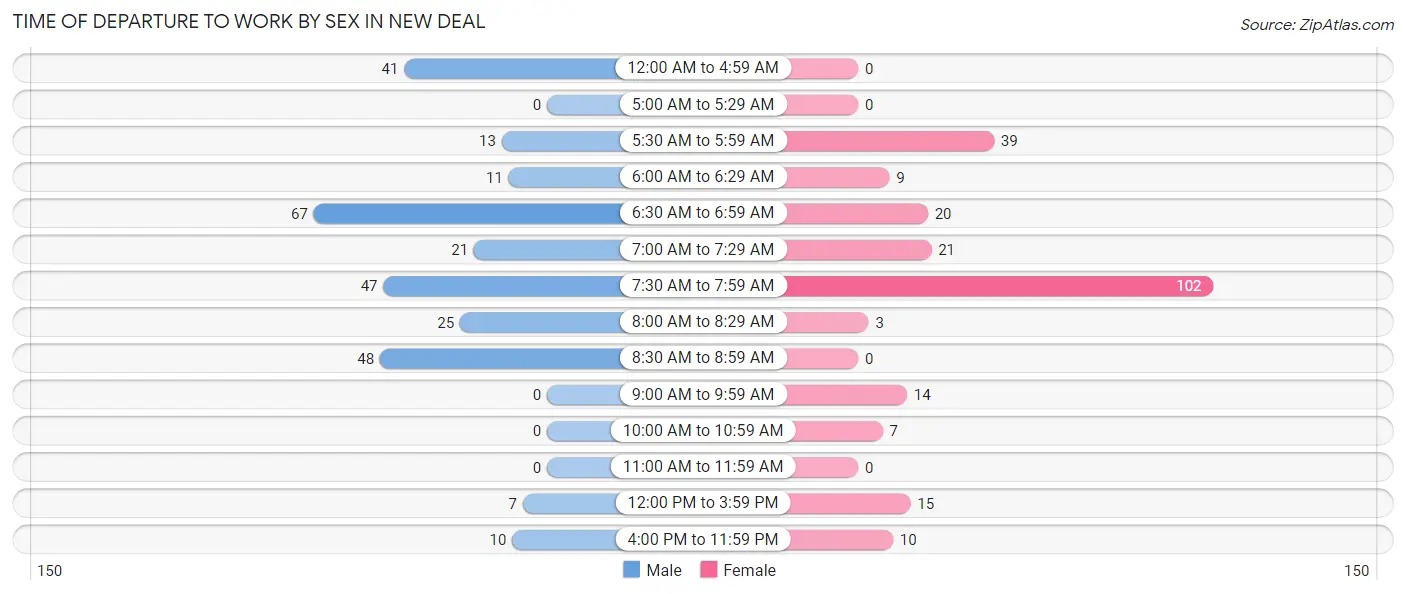
| Time of Departure | Male | Female |
| 12:00 AM to 4:59 AM | 41 (14.1%) | 0 (0.0%) |
| 5:00 AM to 5:29 AM | 0 (0.0%) | 0 (0.0%) |
| 5:30 AM to 5:59 AM | 13 (4.5%) | 39 (16.3%) |
| 6:00 AM to 6:29 AM | 11 (3.8%) | 9 (3.7%) |
| 6:30 AM to 6:59 AM | 67 (23.1%) | 20 (8.3%) |
| 7:00 AM to 7:29 AM | 21 (7.2%) | 21 (8.7%) |
| 7:30 AM to 7:59 AM | 47 (16.2%) | 102 (42.5%) |
| 8:00 AM to 8:29 AM | 25 (8.6%) | 3 (1.3%) |
| 8:30 AM to 8:59 AM | 48 (16.6%) | 0 (0.0%) |
| 9:00 AM to 9:59 AM | 0 (0.0%) | 14 (5.8%) |
| 10:00 AM to 10:59 AM | 0 (0.0%) | 7 (2.9%) |
| 11:00 AM to 11:59 AM | 0 (0.0%) | 0 (0.0%) |
| 12:00 PM to 3:59 PM | 7 (2.4%) | 15 (6.2%) |
| 4:00 PM to 11:59 PM | 10 (3.5%) | 10 (4.2%) |
| Total | 290 (100.0%) | 240 (100.0%) |
Housing Occupancy in New Deal
Occupancy by Ownership in New Deal
Of the total 401 dwellings in New Deal, owner-occupied units account for 371 (92.5%), while renter-occupied units make up 30 (7.5%).

| Occupancy | # Housing Units | % Housing Units |
| Owner Occupied Housing Units | 371 | 92.5% |
| Renter-Occupied Housing Units | 30 | 7.5% |
| Total Occupied Housing Units | 401 | 100.0% |
Occupancy by Household Size in New Deal

| Household Size | # Housing Units | % Housing Units |
| 1-Person Household | 88 | 22.0% |
| 2-Person Household | 100 | 24.9% |
| 3-Person Household | 91 | 22.7% |
| 4+ Person Household | 122 | 30.4% |
| Total Housing Units | 401 | 100.0% |
Occupancy by Ownership by Household Size in New Deal

| Household Size | Owner-occupied | Renter-occupied |
| 1-Person Household | 88 (100.0%) | 0 (0.0%) |
| 2-Person Household | 92 (92.0%) | 8 (8.0%) |
| 3-Person Household | 91 (100.0%) | 0 (0.0%) |
| 4+ Person Household | 100 (82.0%) | 22 (18.0%) |
| Total Housing Units | 371 (92.5%) | 30 (7.5%) |
Occupancy by Educational Attainment in New Deal

| Household Size | Owner-occupied | Renter-occupied |
| Less than High School | 93 (100.0%) | 0 (0.0%) |
| High School Diploma | 92 (79.3%) | 24 (20.7%) |
| College/Associate Degree | 158 (98.8%) | 2 (1.3%) |
| Bachelor's Degree or higher | 28 (87.5%) | 4 (12.5%) |
Occupancy by Age of Householder in New Deal

| Age Bracket | # Households | % Households |
| Under 35 Years | 25 | 6.2% |
| 35 to 44 Years | 73 | 18.2% |
| 45 to 54 Years | 133 | 33.2% |
| 55 to 64 Years | 75 | 18.7% |
| 65 to 74 Years | 28 | 7.0% |
| 75 to 84 Years | 52 | 13.0% |
| 85 Years and Over | 15 | 3.7% |
| Total | 401 | 100.0% |
Housing Finances in New Deal
Median Income by Occupancy in New Deal

| Occupancy Type | # Households | Median Income |
| Owner-Occupied | 371 (92.5%) | $81,250 |
| Renter-Occupied | 30 (7.5%) | $0 |
| Average | 401 (100.0%) | $76,964 |
Occupancy by Householder Income Bracket in New Deal
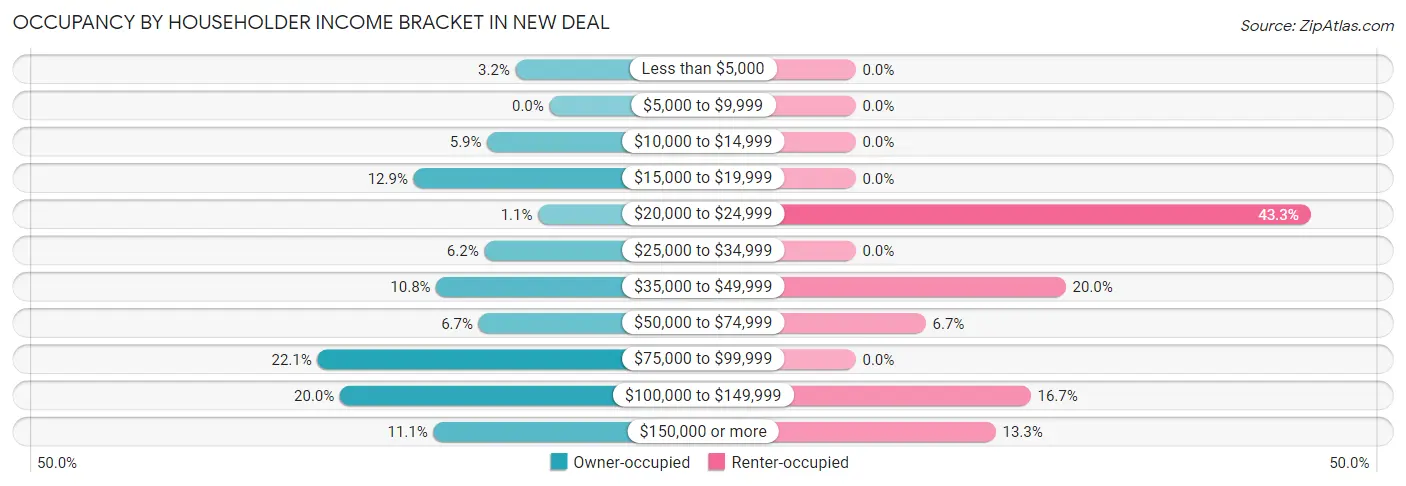
| Income Bracket | Owner-occupied | Renter-occupied |
| Less than $5,000 | 12 (3.2%) | 0 (0.0%) |
| $5,000 to $9,999 | 0 (0.0%) | 0 (0.0%) |
| $10,000 to $14,999 | 22 (5.9%) | 0 (0.0%) |
| $15,000 to $19,999 | 48 (12.9%) | 0 (0.0%) |
| $20,000 to $24,999 | 4 (1.1%) | 13 (43.3%) |
| $25,000 to $34,999 | 23 (6.2%) | 0 (0.0%) |
| $35,000 to $49,999 | 40 (10.8%) | 6 (20.0%) |
| $50,000 to $74,999 | 25 (6.7%) | 2 (6.7%) |
| $75,000 to $99,999 | 82 (22.1%) | 0 (0.0%) |
| $100,000 to $149,999 | 74 (20.0%) | 5 (16.7%) |
| $150,000 or more | 41 (11.1%) | 4 (13.3%) |
| Total | 371 (100.0%) | 30 (100.0%) |
Monthly Housing Cost Tiers in New Deal

| Monthly Cost | Owner-occupied | Renter-occupied |
| Less than $300 | 48 (12.9%) | 0 (0.0%) |
| $300 to $499 | 84 (22.6%) | 0 (0.0%) |
| $500 to $799 | 60 (16.2%) | 6 (20.0%) |
| $800 to $999 | 19 (5.1%) | 0 (0.0%) |
| $1,000 to $1,499 | 138 (37.2%) | 20 (66.7%) |
| $1,500 to $1,999 | 15 (4.0%) | 0 (0.0%) |
| $2,000 to $2,499 | 0 (0.0%) | 4 (13.3%) |
| $2,500 to $2,999 | 0 (0.0%) | 0 (0.0%) |
| $3,000 or more | 7 (1.9%) | 0 (0.0%) |
| Total | 371 (100.0%) | 30 (100.0%) |
Physical Housing Characteristics in New Deal
Housing Structures in New Deal

| Structure Type | # Housing Units | % Housing Units |
| Single Unit, Detached | 207 | 51.6% |
| Single Unit, Attached | 0 | 0.0% |
| 2 Unit Apartments | 0 | 0.0% |
| 3 or 4 Unit Apartments | 0 | 0.0% |
| 5 to 9 Unit Apartments | 0 | 0.0% |
| 10 or more Apartments | 0 | 0.0% |
| Mobile Home / Other | 194 | 48.4% |
| Total | 401 | 100.0% |
Housing Structures by Occupancy in New Deal

| Structure Type | Owner-occupied | Renter-occupied |
| Single Unit, Detached | 198 (95.7%) | 9 (4.3%) |
| Single Unit, Attached | 0 (0.0%) | 0 (0.0%) |
| 2 Unit Apartments | 0 (0.0%) | 0 (0.0%) |
| 3 or 4 Unit Apartments | 0 (0.0%) | 0 (0.0%) |
| 5 to 9 Unit Apartments | 0 (0.0%) | 0 (0.0%) |
| 10 or more Apartments | 0 (0.0%) | 0 (0.0%) |
| Mobile Home / Other | 173 (89.2%) | 21 (10.8%) |
| Total | 371 (92.5%) | 30 (7.5%) |
Housing Structures by Number of Rooms in New Deal

| Number of Rooms | Owner-occupied | Renter-occupied |
| 1 Room | 0 (0.0%) | 0 (0.0%) |
| 2 or 3 Rooms | 0 (0.0%) | 0 (0.0%) |
| 4 or 5 Rooms | 175 (47.2%) | 26 (86.7%) |
| 6 or 7 Rooms | 159 (42.9%) | 4 (13.3%) |
| 8 or more Rooms | 37 (10.0%) | 0 (0.0%) |
| Total | 371 (100.0%) | 30 (100.0%) |
Housing Structure by Heating Type in New Deal

| Heating Type | Owner-occupied | Renter-occupied |
| Utility Gas | 197 (53.1%) | 11 (36.7%) |
| Bottled, Tank, or LP Gas | 5 (1.3%) | 0 (0.0%) |
| Electricity | 169 (45.6%) | 19 (63.3%) |
| Fuel Oil or Kerosene | 0 (0.0%) | 0 (0.0%) |
| Coal or Coke | 0 (0.0%) | 0 (0.0%) |
| All other Fuels | 0 (0.0%) | 0 (0.0%) |
| No Fuel Used | 0 (0.0%) | 0 (0.0%) |
| Total | 371 (100.0%) | 30 (100.0%) |
Household Vehicle Usage in New Deal

| Vehicles per Household | Owner-occupied | Renter-occupied |
| No Vehicle | 29 (7.8%) | 0 (0.0%) |
| 1 Vehicle | 70 (18.9%) | 19 (63.3%) |
| 2 Vehicles | 153 (41.2%) | 6 (20.0%) |
| 3 or more Vehicles | 119 (32.1%) | 5 (16.7%) |
| Total | 371 (100.0%) | 30 (100.0%) |
Real Estate & Mortgages in New Deal
Real Estate and Mortgage Overview in New Deal
| Characteristic | Without Mortgage | With Mortgage |
| Housing Units | 188 | 183 |
| Median Property Value | $61,100 | $89,200 |
| Median Household Income | $42,875 | $41 |
| Monthly Housing Costs | $368 | $7 |
| Real Estate Taxes | $381 | $2 |
Property Value by Mortgage Status in New Deal

| Property Value | Without Mortgage | With Mortgage |
| Less than $50,000 | 78 (41.5%) | 73 (39.9%) |
| $50,000 to $99,999 | 45 (23.9%) | 20 (10.9%) |
| $100,000 to $299,999 | 61 (32.5%) | 90 (49.2%) |
| $300,000 to $499,999 | 4 (2.1%) | 0 (0.0%) |
| $500,000 to $749,999 | 0 (0.0%) | 0 (0.0%) |
| $750,000 to $999,999 | 0 (0.0%) | 0 (0.0%) |
| $1,000,000 or more | 0 (0.0%) | 0 (0.0%) |
| Total | 188 (100.0%) | 183 (100.0%) |
Household Income by Mortgage Status in New Deal

| Household Income | Without Mortgage | With Mortgage |
| Less than $10,000 | 0 (0.0%) | 0 (0.0%) |
| $10,000 to $24,999 | 74 (39.4%) | 12 (6.6%) |
| $25,000 to $34,999 | 14 (7.4%) | 0 (0.0%) |
| $35,000 to $49,999 | 40 (21.3%) | 9 (4.9%) |
| $50,000 to $74,999 | 13 (6.9%) | 0 (0.0%) |
| $75,000 to $99,999 | 16 (8.5%) | 12 (6.6%) |
| $100,000 to $149,999 | 31 (16.5%) | 66 (36.1%) |
| $150,000 or more | 0 (0.0%) | 43 (23.5%) |
| Total | 188 (100.0%) | 183 (100.0%) |
Property Value to Household Income Ratio in New Deal

| Value-to-Income Ratio | Without Mortgage | With Mortgage |
| Less than 2.0x | 131 (69.7%) | 98,295 (53,713.1%) |
| 2.0x to 2.9x | 19 (10.1%) | 141 (77.0%) |
| 3.0x to 3.9x | 5 (2.7%) | 18 (9.8%) |
| 4.0x or more | 33 (17.5%) | 12 (6.6%) |
| Total | 188 (100.0%) | 183 (100.0%) |
Real Estate Taxes by Mortgage Status in New Deal

| Property Taxes | Without Mortgage | With Mortgage |
| Less than $800 | 123 (65.4%) | 12 (6.6%) |
| $800 to $1,499 | 34 (18.1%) | 61 (33.3%) |
| $800 to $1,499 | 24 (12.8%) | 44 (24.0%) |
| Total | 188 (100.0%) | 183 (100.0%) |
Health & Disability in New Deal
Health Insurance Coverage by Age in New Deal

| Age Bracket | With Coverage | Without Coverage |
| Under 6 Years | 45 (100.0%) | 0 (0.0%) |
| 6 to 18 Years | 303 (94.1%) | 19 (5.9%) |
| 19 to 25 Years | 111 (88.1%) | 15 (11.9%) |
| 26 to 34 Years | 29 (36.2%) | 51 (63.7%) |
| 35 to 44 Years | 83 (79.8%) | 21 (20.2%) |
| 45 to 54 Years | 225 (90.0%) | 25 (10.0%) |
| 55 to 64 Years | 82 (73.9%) | 29 (26.1%) |
| 65 to 74 Years | 90 (100.0%) | 0 (0.0%) |
| 75 Years and older | 89 (100.0%) | 0 (0.0%) |
| Total | 1,057 (86.9%) | 160 (13.2%) |
Health Insurance Coverage by Citizenship Status in New Deal

| Citizenship Status | With Coverage | Without Coverage |
| Native Born | 45 (100.0%) | 0 (0.0%) |
| Foreign Born, Citizen | 303 (94.1%) | 19 (5.9%) |
| Foreign Born, not a Citizen | 111 (88.1%) | 15 (11.9%) |
Health Insurance Coverage by Household Income in New Deal

| Household Income | With Coverage | Without Coverage |
| Under $25,000 | 228 (80.0%) | 57 (20.0%) |
| $25,000 to $49,999 | 129 (93.5%) | 9 (6.5%) |
| $50,000 to $74,999 | 63 (96.9%) | 2 (3.1%) |
| $75,000 to $99,999 | 235 (90.4%) | 25 (9.6%) |
| $100,000 and over | 402 (85.7%) | 67 (14.3%) |
Public vs Private Health Insurance Coverage by Age in New Deal

| Age Bracket | Public Insurance | Private Insurance |
| Under 6 | 33 (73.3%) | 12 (26.7%) |
| 6 to 18 Years | 208 (64.6%) | 103 (32.0%) |
| 19 to 25 Years | 7 (5.6%) | 104 (82.5%) |
| 25 to 34 Years | 0 (0.0%) | 29 (36.2%) |
| 35 to 44 Years | 14 (13.5%) | 76 (73.1%) |
| 45 to 54 Years | 8 (3.2%) | 225 (90.0%) |
| 55 to 64 Years | 14 (12.6%) | 69 (62.2%) |
| 65 to 74 Years | 90 (100.0%) | 36 (40.0%) |
| 75 Years and over | 89 (100.0%) | 40 (44.9%) |
| Total | 463 (38.0%) | 694 (57.0%) |
Disability Status by Sex by Age in New Deal

| Age Bracket | Male | Female |
| Under 5 Years | 0 (0.0%) | 0 (0.0%) |
| 5 to 17 Years | 53 (29.0%) | 21 (20.0%) |
| 18 to 34 Years | 0 (0.0%) | 7 (6.7%) |
| 35 to 64 Years | 23 (12.0%) | 28 (10.3%) |
| 65 to 74 Years | 23 (65.7%) | 36 (65.4%) |
| 75 Years and over | 21 (84.0%) | 35 (54.7%) |
Disability Class by Sex by Age in New Deal
Disability Class: Hearing Difficulty

| Age Bracket | Male | Female |
| Under 5 Years | 0 (0.0%) | 0 (0.0%) |
| 5 to 17 Years | 21 (11.5%) | 0 (0.0%) |
| 18 to 34 Years | 0 (0.0%) | 7 (6.7%) |
| 35 to 64 Years | 20 (10.4%) | 0 (0.0%) |
| 65 to 74 Years | 13 (37.1%) | 30 (54.5%) |
| 75 Years and over | 12 (48.0%) | 4 (6.2%) |
Disability Class: Vision Difficulty

| Age Bracket | Male | Female |
| Under 5 Years | 0 (0.0%) | 0 (0.0%) |
| 5 to 17 Years | 0 (0.0%) | 0 (0.0%) |
| 18 to 34 Years | 0 (0.0%) | 7 (6.7%) |
| 35 to 64 Years | 0 (0.0%) | 0 (0.0%) |
| 65 to 74 Years | 10 (28.6%) | 2 (3.6%) |
| 75 Years and over | 0 (0.0%) | 0 (0.0%) |
Disability Class: Cognitive Difficulty

| Age Bracket | Male | Female |
| 5 to 17 Years | 32 (17.5%) | 21 (20.0%) |
| 18 to 34 Years | 0 (0.0%) | 7 (6.7%) |
| 35 to 64 Years | 0 (0.0%) | 15 (5.5%) |
| 65 to 74 Years | 0 (0.0%) | 25 (45.5%) |
| 75 Years and over | 2 (8.0%) | 4 (6.2%) |
Disability Class: Ambulatory Difficulty

| Age Bracket | Male | Female |
| 5 to 17 Years | 0 (0.0%) | 0 (0.0%) |
| 18 to 34 Years | 0 (0.0%) | 7 (6.7%) |
| 35 to 64 Years | 14 (7.3%) | 21 (7.7%) |
| 65 to 74 Years | 0 (0.0%) | 34 (61.8%) |
| 75 Years and over | 11 (44.0%) | 35 (54.7%) |
Disability Class: Self-Care Difficulty

| Age Bracket | Male | Female |
| 5 to 17 Years | 0 (0.0%) | 0 (0.0%) |
| 18 to 34 Years | 0 (0.0%) | 7 (6.7%) |
| 35 to 64 Years | 0 (0.0%) | 8 (2.9%) |
| 65 to 74 Years | 0 (0.0%) | 2 (3.6%) |
| 75 Years and over | 0 (0.0%) | 0 (0.0%) |
Technology Access in New Deal
Computing Device Access in New Deal

| Device Type | # Households | % Households |
| Desktop or Laptop | 269 | 67.1% |
| Smartphone | 351 | 87.5% |
| Tablet | 208 | 51.9% |
| No Computing Device | 18 | 4.5% |
| Total | 401 | 100.0% |
Internet Access in New Deal

| Internet Type | # Households | % Households |
| Dial-Up Internet | 9 | 2.2% |
| Broadband Home | 279 | 69.6% |
| Cellular Data Only | 53 | 13.2% |
| Satellite Internet | 26 | 6.5% |
| No Internet | 47 | 11.7% |
| Total | 401 | 100.0% |
New Deal Summary
New Deal, Texas is a small town located in the northern part of Lubbock County, Texas. It is situated about 15 miles northeast of the city of Lubbock. The town was founded in the early 1900s and was named after President Franklin D. Roosevelt’s New Deal program. The town has a population of about 1,000 people and is part of the Lubbock Metropolitan Statistical Area.
Geography
New Deal is located in the northern part of Lubbock County, Texas. It is situated about 15 miles northeast of the city of Lubbock. The town is located in the High Plains region of Texas, which is characterized by flat terrain and dry climate. The town is situated at an elevation of 3,000 feet above sea level. The town is surrounded by agricultural land and is located near the Double Mountain Fork of the Brazos River.
Economy
The economy of New Deal is largely based on agriculture. The town is surrounded by agricultural land and is home to several farms and ranches. The town is also home to a few small businesses, including a grocery store, a hardware store, and a few restaurants. The town is also home to a few manufacturing companies, including a plastics factory and a metal fabrication plant.
Demographics
As of the 2010 census, the population of New Deal was 1,000 people. The racial makeup of the town was 94.2% White, 0.7% African American, 0.3% Native American, 0.2% Asian, 0.1% Pacific Islander, 2.7% from other races, and 1.7% from two or more races. Hispanic or Latino of any race were 5.7% of the population.
The median income for a household in New Deal was $37,500, and the median income for a family was $41,250. The per capita income for the town was $17,845. About 11.2% of families and 13.2% of the population were below the poverty line, including 16.7% of those under age 18 and 8.3% of those age 65 or over.
History
New Deal was founded in the early 1900s and was named after President Franklin D. Roosevelt’s New Deal program. The town was originally a farming community and was home to several cotton gins. The town was also home to a few small businesses, including a grocery store, a hardware store, and a few restaurants.
In the 1950s, the town began to experience a population decline as many of its residents moved to larger cities in search of better job opportunities. The town’s population continued to decline until the late 1990s when the town began to experience a population increase due to the influx of new residents from other parts of Texas.
Today, New Deal is a small town with a population of about 1,000 people. The town is home to several farms and ranches and is also home to a few small businesses. The town is also home to a few manufacturing companies, including a plastics factory and a metal fabrication plant.
Common Questions
What is Per Capita Income in New Deal?
Per Capita income in New Deal is $26,216.
What is the Median Family Income in New Deal?
Median Family Income in New Deal is $90,217.
What is the Median Household income in New Deal?
Median Household Income in New Deal is $76,964.
What is Income or Wage Gap in New Deal?
Income or Wage Gap in New Deal is 25.0%.
Women in New Deal earn 75.0 cents for every dollar earned by a man.
What is Inequality or Gini Index in New Deal?
Inequality or Gini Index in New Deal is 0.39.
What is the Total Population of New Deal?
Total Population of New Deal is 1,217.
What is the Total Male Population of New Deal?
Total Male Population of New Deal is 606.
What is the Total Female Population of New Deal?
Total Female Population of New Deal is 611.
What is the Ratio of Males per 100 Females in New Deal?
There are 99.18 Males per 100 Females in New Deal.
What is the Ratio of Females per 100 Males in New Deal?
There are 100.83 Females per 100 Males in New Deal.
What is the Median Population Age in New Deal?
Median Population Age in New Deal is 39.1 Years.
What is the Average Family Size in New Deal
Average Family Size in New Deal is 3.4 People.
What is the Average Household Size in New Deal
Average Household Size in New Deal is 3.0 People.
How Large is the Labor Force in New Deal?
There are 643 People in the Labor Forcein in New Deal.
What is the Percentage of People in the Labor Force in New Deal?
68.8% of People are in the Labor Force in New Deal.
What is the Unemployment Rate in New Deal?
Unemployment Rate in New Deal is 0.5%.